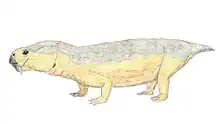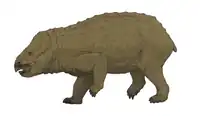| Kingoriidae | |
|---|---|
 | |
| Restoration of Dicynodontoides recurvidens | |
| Scientific classification | |
| Domain: | Eukaryota |
| Kingdom: | Animalia |
| Phylum: | Chordata |
| Clade: | Synapsida |
| Clade: | Therapsida |
| Suborder: | †Anomodontia |
| Clade: | †Dicynodontia |
| Clade: | †Kistecephalia |
| Family: | †Kingoriidae King, 1988 |
| Genera | |
Kingoriidae is an extinct family of dicynodont therapsids. It includes the Late Permian Niassodon,[2] Thliptosaurus,[3] Dicynodontoides (initially called Kingoria) and the Triassic Kombuisia.[4]
References
Wikimedia Commons has media related to Kingoriidae.
- ↑ Kingoriidae in the Paleobiology Database
- ↑ Castanhinha, R.; Araújo, R.; Júnior, L. C.; Angielczyk, K. D.; Martins, G. G.; Martins, R. M. S.; Chaouiya, C.; Beckmann, F.; Wilde, F. (2014). "Bringing Dicynodonts Back to Life: Paleobiology and Anatomy of a New Emydopoid Genus from the Upper Permian of Mozambique". PLOS ONE. 9 (4): e80974. doi:10.1371/journal.pone.0080974. PMC 3852158. PMID 24324653.
- ↑ Kammerer, Christian F. (2019). "A new dicynodont (Anomodontia: Emydopoidea) from the terminal Permian of KwaZulu-Natal, South Africa". Palaeontologia Africana. 53: 179–191. ISSN 2410-4418.
- ↑ Kammerer, C.F.; Angielczyk, K.D. (2009). "A proposed higher taxonomy of anomodont therapsids" (PDF). Zootaxa. 2018: 1–24.
This article is issued from Wikipedia. The text is licensed under Creative Commons - Attribution - Sharealike. Additional terms may apply for the media files.




